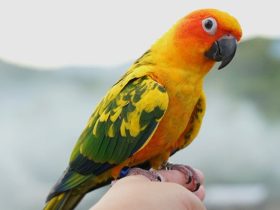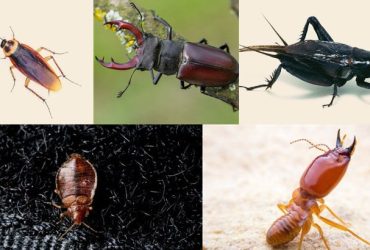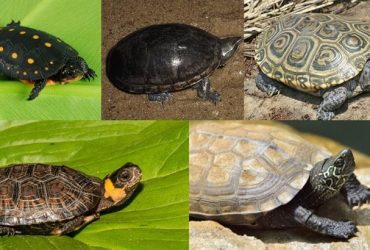Birds are fascinating creatures. There are millions of bird species, each of them with unique characteristics. The most impressive thing about birds is their ability to fly. And while some birds can’t fly, some of them are recognized for their flight.
The best example of this would be the hummingbird — a tiny gentle creature that is named after the humming noise that its wings make while in flight. There’s so much to learn about them, and you can find all the information you need here.
Hummingbirds: Introduction
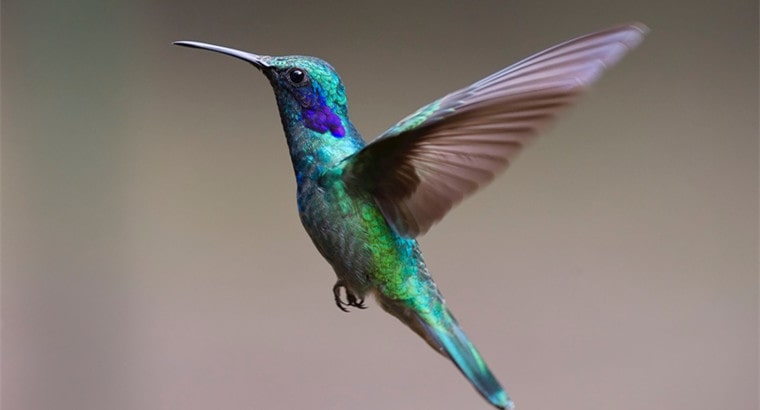
The world’s smallest migrating birds, hummingbirds are an enthralling species. These brightly-colored birds are the only ones that can even fly backward, a nifty trait for feeding. Let’s take a look at some of their other features.
#1. Size
They’re quite tiny; some of them even smaller than the palm of our hands.
The largest species amongst them, the giant hummingbird, which is native to South America, spans a mere 20 cm (8 inches) long and weighs 20 g (0.7 ounces).
Bee hummingbird, the smallest of the hummingbird species, is a tiny 5.5 cm. In this case, it is the beak and their tail that counts for half the length. They weigh only 2 g, reiterating how they’re the smallest living birds ever.
#2. Shape
Their body shape is almost spherical, and for a reason — it helps them conserve energy. Their body heat is retained by their feathers. They’ve got really tiny legs and feet, which renders them incapable of walking properly.
Their beak is long and resembles a needle. With their long wings and streamlined body, they’re quite distinct from other birds.
#3. Color
You can generally notice colors like green, brown, grey, white, red, and tan on hummingbirds’ bodies.
Hummingbirds have quite an impressive plumage. Their brightly colored throat helps recognize their species, with male birds having more colors than female birds.
10 Facts About Hummingbird
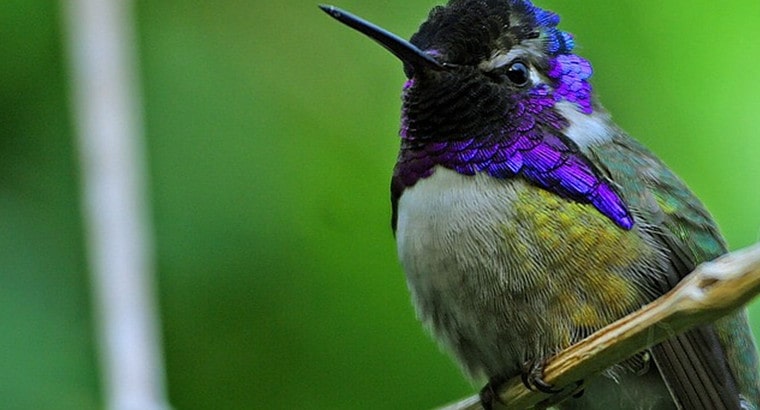
There are a number of facts about these little birds that you ought to know! Here’s a list of some of the most interesting ones:
#1. There exist over 350 known species and 1155 genera of hummingbirds.
#2. They are only found in the western hemisphere, mostly south of the United States. They’re migrating birds, spending their winter in Central America or Mexico, and migrating north to the US around February to breed.
#3. The most common hummingbird species you’d find in America are Allen’s hummingbird, Anna’s hummingbird, Berylline hummingbird, blue-throated hummingbird, and Buff-bellied hummingbird, among others.
#4. Hummingbirds use their tongues similar to the way we use straws, helping them draw nectar from a flower up to twenty times within a second!
#5. Some of the hummingbird species migrate as far as 6000 km.
#6. They need to eat 5-8 times every hour to sustain themselves, or they starve. They consume at least half their body weight every day, and their diet is mostly nectar and a few small insects.
#7. Because of their feeding needs, they cannot sleep overnight as they’d likely starve. So hummingbirds resort to a mini hibernation period called torpor. Their incredibly fast metabolism slows down during this period so they can live through their inactivity.
#8. The typical lifespan of a wild hummingbird would be around 3-5 years. As is the case with most other species, hummingbirds in captivity can live from 12 to 14 years.
#9. They’re prey to other birds as well — roadrunners, shrikes, bats, owls, and more.
#10. A hummingbird’s heart beats over 20 times in a second, translating to over 1200 beats per minute. Interestingly, it is not this high-speed movement, but their wing beating of 50-80 beats per second that is responsible for the humming sound.
What Do They Eat?
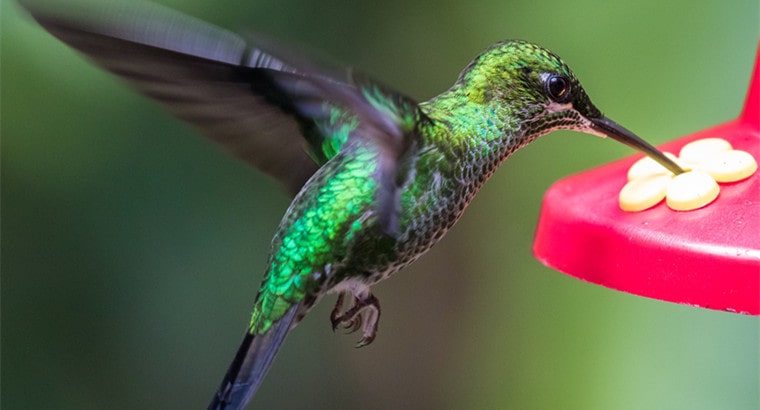
Nectar is the most preferred food for hummingbirds. The pure sugar content in the nectar works well with their insanely high metabolism.
Besides nectar, they get their proteins and fat from the likes of small spiders, insect eggs, larvae, and other tiny insects that they may have to catch mid-air. Adult hummingbirds need to eat several dozen insects a day to match the sugar content in their body with salt.
If they don’t have access to nectar, hummingbirds sip tree sap. Interestingly, they make use of the drills made by woodpeckers to access the tree sap. It is an adequate source of sucrose.
If the sap has solidified too much, they can still pick insects trapped in the sap and consume them.
They sometimes enjoy ripe fruits as well! You may find them silently chilling on top of an exposed pear, apple, or berry. They also ingest sand and ashes to fulfill their mineral necessities, but this may be because they were picking insects from the ground.
How To Attract Hummingbirds to Your Yard?

If you love little birds, you would want to welcome a little hummingbird friend dropping by your backyard every day.
They’re agile, incredibly small, and very cute. In case you’d like to draw one of these wonders into your yard, here are a few pointers to attract them:
#1. If you live in the southwestern parts of the US, you might have spotted a hummingbird or two curiously perched next to the headlights of your car. This is because they tend to naturally investigate anything red in color.
Tube-shaped red flowers from native nectar plants like honeysuckle work best for hummers that pollinate.
#2. Provide an alternative to nectar, such as sugar water. You can make it on your own! Boiling 1 part white sugar with 4 parts of water will give you a sugar solution that hummers will enjoy consuming.
Don’t add any extra coloring!
#3. Clean feeders placed in properly lit and visible areas invite hummingbirds. Make sure you clean out their little dishes often so they don’t get sick consuming the sugar solution you’ve prepared for them.
#4. Space out the feeders; hummingbirds don’t often like feeding together. They’re quite territorial about their food.
#5. Place the feeders in the same spot every year, as they’ve got pretty good spatial memory.
#6. Compact birdbaths and water mists are a delight to hummingbirds, so make sure to have a few in your yard where they can take a dip during spring.
#7. Use bee-resistant feeders, and ant moats as well, so nothing deters a nice session of hummingbird-watching.
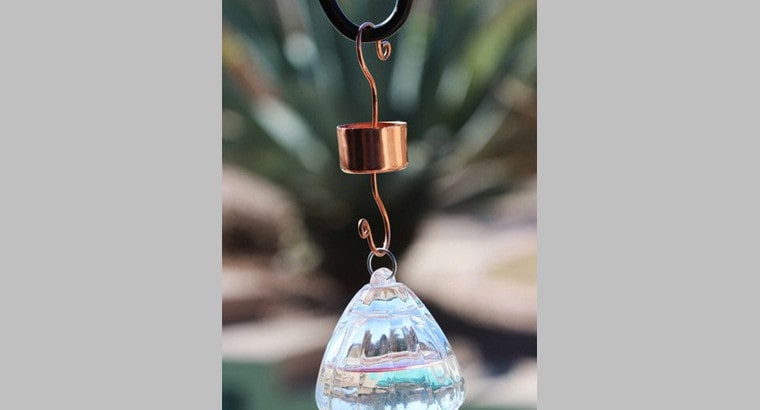
Image source: Pinterest
A Few Parting Words
To witness such an incredibly small yet hard-working creature fight to live every day is quite an eye-opening experience.
Hummingbirds are beautiful and make for great photo inspirations if you love clicking pictures of wildlife. You can use the tips above to get hummingbirds to return to your yard every year; they’re loyal creatures after all! You just need to be ready with your camera and be sure you capture some great photos for your photo album. They’re extremely colourful birds and if you’ve got a good camera and get a high-quality album you can marvel at their beauty whenever you feel like it.







